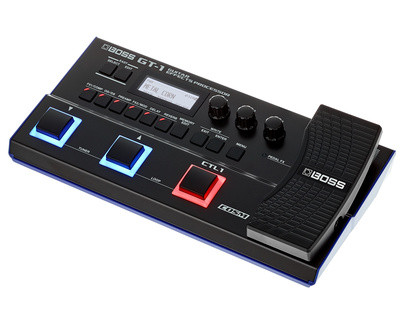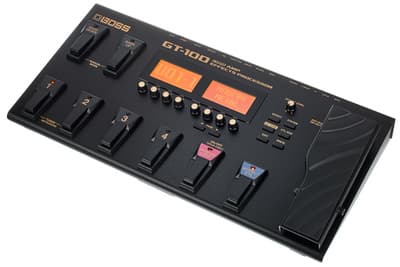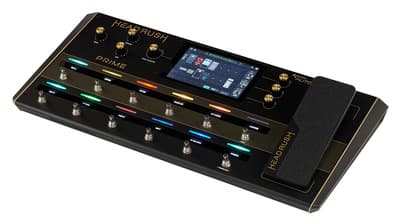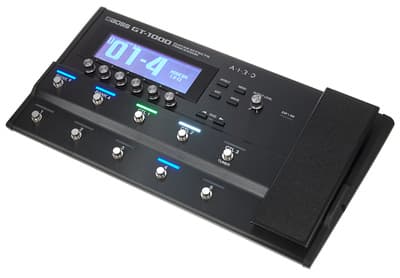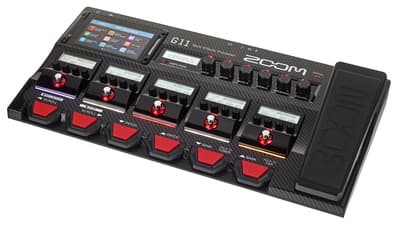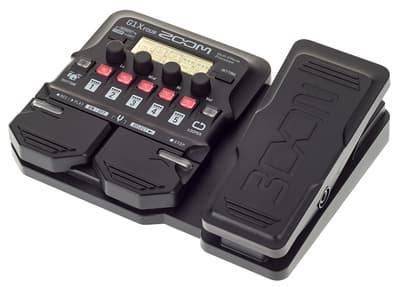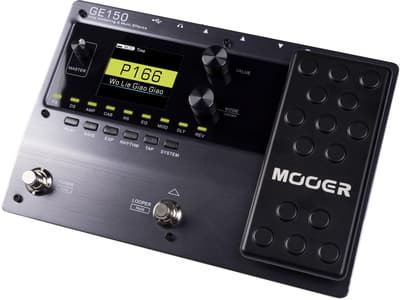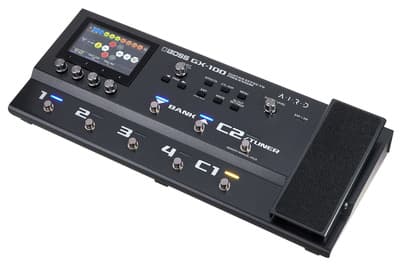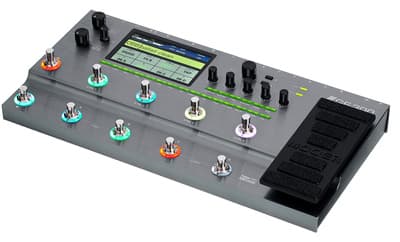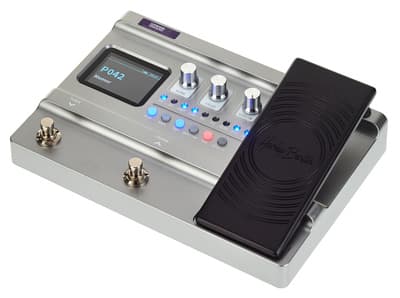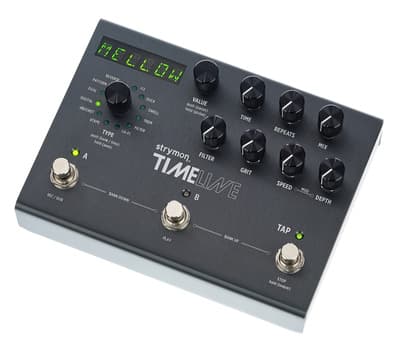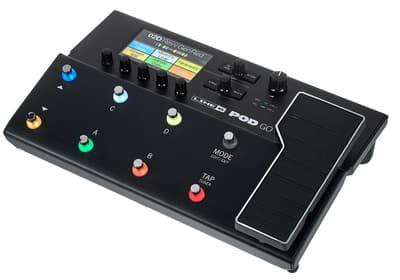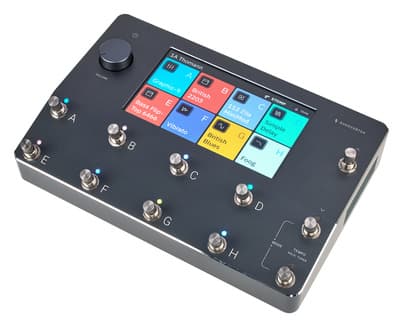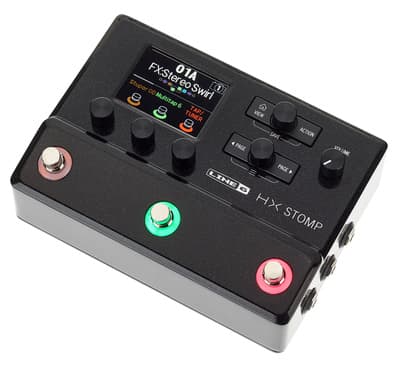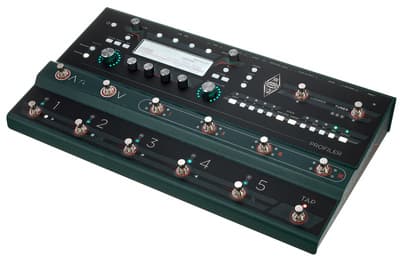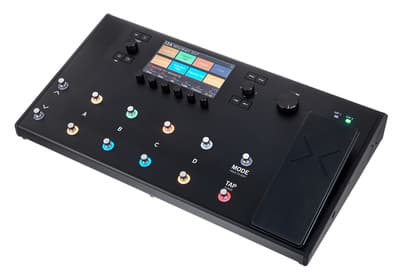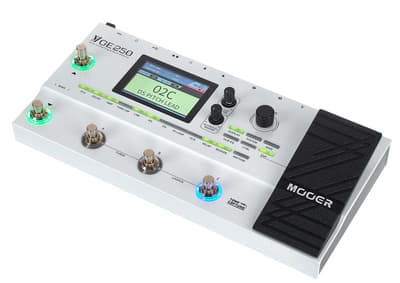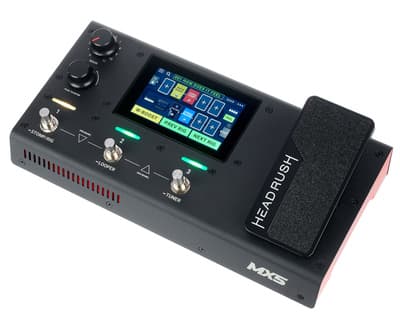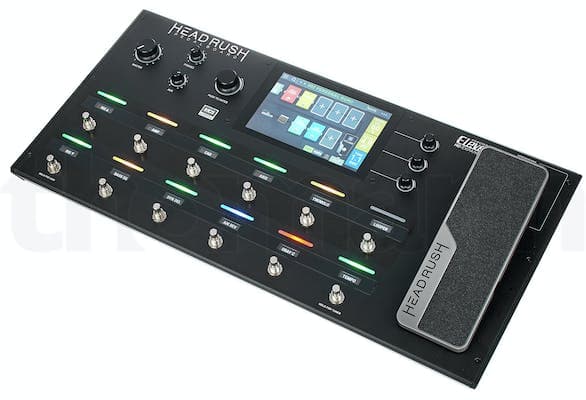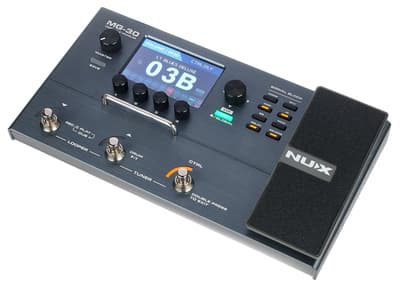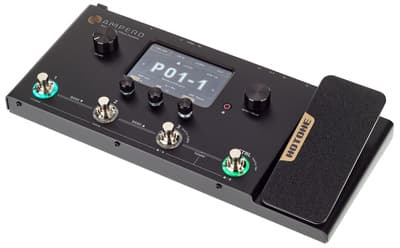Boss GT-1 – Field Report
A versatile multi-effects unit with great sound for beginners.
Roland has had the Boss GT-1 in its range for several years, offering guitar beginners a multi-effects unit. It offers the same sound engine as the GT-100, which is twice as expensive, but is available at an affordable price.
But what compromises do beginners have to make? Is it worth paying the higher price compared to other beginner devices? In our review, we take a closer look at the GT-1 to find out.
Features and technical data
Memory slots
The GT-1 offers 108 effects to choose from in its floorboard-style housing. These can be combined into patches, 99 of which can be stored on the device. In addition to the user-defined patches, there are 99 pre-installed Roland presets covering numerous styles and sound preferences. Although the pre-installed patches cannot be deleted, this is not a practical issue due to the generous amount of memory available.
Switches & connections
In addition to its internal features, the GT-1 impresses with its black and blue housing with no sharp edges. Measuring 30.5 x 15.2 x 5.6 cm and weighing 1.3 kg, the device has three large foot switches on its top panel that can be used to navigate between patches and switch between sounds, such as rhythm and solo, within a patch. An integrated expression pedal is located on the far right of the GT-1. The respective effect types of a patch can be controlled directly via six smaller illuminated buttons. Three rotary controls enable adjustment of the values displayed on the backlit screen.
At the rear of the GT-1, you can connect your guitar and expand the device with optional pedals via 6.3 mm jack connections. There is also an auxiliary input in the form of a small jack. This enables audio sources, such as MP3 players, to be connected and looped directly into the output. The GT-1's output can be operated in stereo via two 6.3 mm jack connections. Alternatively, the left jack can be used as a mono output. You can also connect headphones via a mini jack. The GT-1 can be connected to a PC or Mac via a USB port.
Power supply
However, we find the power supply options for the GT-1 somewhat limited. The scope of delivery is limited to four AA batteries, which enable the GT-1 to operate for just under seven hours – significantly less than competing devices. Although there is a power connection on the back of the GT-1, the appropriate power supply unit is not included in the sales package. If you wish to operate your GT-1 via a power supply unit, you will need to pay Boss an additional £25.
Tuner & looper
As additional features, Boss has equipped the GT-1 with a tuner and a looper. The tuner can be activated by pressing the up and down buttons simultaneously, after which it shows on the display whether the string is too high or too low using a scale and the illumination of the large foot switches. The looper can be activated in a similar way by pressing the middle and right foot switches simultaneously. It records 32 seconds of your performance and enables you to layer multiple recordings.
Effects and presets
With 108 different effects, the Boss GT-1 can be adapted to practically any desired sound. Despite its significantly lower price, the GT-1 uses the same sound engine as the GT-100, as previously mentioned. Boss refers to this as its 'flagship engine'. Accordingly, we believe that the GT-1's sound quality is exceptional.
The effects are divided into six categories, each of which is represented by a button on the device. These can be configured in detail.
FX1: Configurable, e.g. compressor, wah-wah, octave or chorus
OD/DS: Overdrive or distortion
PREAMP: Preamplifier
FX2/MOD: Configurable effects, e.g. compressor, flanger, phaser or limiter
DELAY: Delay/echo effect
REVERB: Reverb
With its 27 preamp settings, the GT-1 offers a rich selection of simulated amplifiers. Here are some of the highlights:
HiGAIN STK: High-gain stack with a sound based on Marshall amplifiers
JC-120: Simulation of Roland's JC-120 amplifier
CLEAN TWIN: Fender Twin Reverb
TWEED: Fender Bassman
BG LEAD: The sound of a MESA/Boogie combo amp
T-AMP LD: Hughes & Kettner Triamp AMP3
ORNG ROCK: Orange Rockreverb
With 22 effects, the range of overdrives and distortions should also leave nothing to be desired for beginners. In this category, the Boss GT-1 offers the following, among other things:
BLUES OD: Crunch sound of the Boss BD-2
OD-1: Simulation of the Boss OD-1 distortion device
RAT: Proco Rat
GUV DS: Marshall Guv'nor
DST+: MXR Distortion +
60S FUZZ: Simulates a Fuzz Face
If you're a beginner who would rather use preset patches than create your own, the GT-1 offers a generous selection of 99 ready-made variants that sound excellent, in our experience. The presets cover a wide range of genres and techniques:
HI GAIN STACK: Powerful hard rock sound
AC SIM STRAIGHT: Simulates the sound of acoustic guitars
FAT BLUESY LEAD: Blues-Lead-Sound
GREAT ROCK: Hard rock sound of the '90s
MODERN METAL: Powerful metal sound for riffs and solos
FUNKY GROOVE: Sound for jazz/funk strumming
COUNTRY PICKIN': Classic country sound
We have no complaints regarding the sound quality of the effects and presets. Clearly, Boss has incorporated the sound engine from its more expensive devices into the GT-1, which is definitely a plus. We also think that the acoustic guitar simulation on the GT-1 is particularly impressive, given that it is often difficult to simulate acoustic sound digitally. However, with the GT-1, Boss has managed to create a very convincing simulation.
You can take a closer look at the effects and preset settings in this manufacturer PDF to get an idea of the GT-1's many sound possibilities before you buy.
Operation
Despite the large number of effects, we found the Boss GT-1 simple and intuitive to operate. Most people should be able to get by without even studying the included manual. However, there's no need to worry about reading the manual for the Boss GT-1 as, at just 12 pages long, it's more of a booklet than a book.
After switching on
The device will switch on or off automatically when you connect or disconnect your guitar at the rear. Once switched on, the GT-1 enters play mode, enabling you to start playing immediately. You can select the current patch by pressing the left and centre foot switches, or by turning the left rotary knob. The right foot switch (CTL1) performs different functions depending on the patch selected, but is generally used to switch between rhythm and lead sounds.
You can change and adjust effects
The patch effect chain is physically represented on the device by six corresponding buttons. Each button has a red LED that lights up when the respective effect type is active in the patch. To change an effect's parameters, press and hold the corresponding button until the display changes. You can then adjust the values using the three rotary knobs.
The three rotary knobs are a central component of the GT-1's operating concept. The bottom of the display always shows what can be changed using the rotary knobs in the appropriate order. An Easy Select button located at the top right of the device allows you to select a patch by genre. The adjacent Easy Edit button takes you to a mode where you can make direct changes using the Tone, Vibes and Echo rotary controls. This further simplifies operation.
Connecting the BOSS GT-1 to a computer
The GT-1 can be connected to a PC or Mac via a USB cable. Boss provides the free Tone Studio application for this purpose, which allows you to manage your presets on a larger screen. A special feature of Tone Studio is that the software also enables you to download and install new presets from the Tone-Central-Website. There, you can choose from patches featuring the sounds of numerous renowned guitarists, such as Marty Friedman and Herman Li, who introduce their patches in videos.
Conclusion
The Boss GT-1 produces sound quality that should satisfy even the most advanced users. In our experience, beginners will find the impressive range of effects and settings leaves nothing to be desired. The device is pleasant to use overall, and the Tone Studio is a useful addition for comfortably editing patches. The only thing detracting from an otherwise extremely positive impression is the lack of a power supply included with the multi-effects unit. This seems like an additional cost, as most users will probably need to purchase a power supply separately. Therefore, if you decide to purchase the GT-1, you should factor in the additional cost of a power supply.
Overall, the GT-1 is an excellent pedalboard. Despite its relatively high price of around £180 for a beginner's device, we believe it is well worth the investment. If the GT-1 is within your budget, you won't be disappointed. Thanks to its good sound quality and well-designed controls, the GT-1 from Boss is a smart choice for both the rehearsal room and your first gigs.
More reviews
Publish date:
Last updated:
